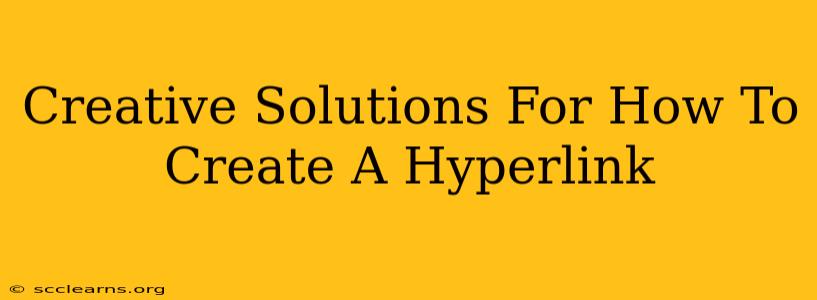Creating hyperlinks might seem basic, but there's a world of creative possibilities beyond the simple click. This post explores diverse methods, catering to various technical skills and platforms, ultimately helping you master the art of the hyperlink and boost your online presence.
Understanding the Basics: What is a Hyperlink?
Before diving into creative applications, let's solidify the foundation. A hyperlink, or simply a link, is a clickable word, phrase, or image that takes a user to another location online. This "location" could be another page on your website, an external website, a specific section of a document, or even an email address. The magic lies in its ability to connect information seamlessly, enriching the user experience and improving navigation.
Key Components of a Hyperlink:
- Anchor Text: The visible text users click on. Choosing descriptive anchor text improves SEO and user experience. For example, instead of "Click here," use "Learn more about SEO."
- URL (Uniform Resource Locator): The web address the link points to. This is the destination of the click.
- HTML Tags (for web pages):
<a href="URL">Anchor Text</a>This is the underlying code that makes the link work.
Creative Hyperlink Applications Beyond the Basics
Now for the exciting part – let's explore inventive ways to utilize hyperlinks:
1. Enhancing User Experience with Contextual Links
Don't just drop links randomly. Integrate them seamlessly within your content. This makes for a smoother reading experience and demonstrates your understanding of user needs. For instance, if you mention a specific tool, link directly to its website.
2. Image Hyperlinks: A Visual Feast
Images aren't just for decoration; they're powerful link carriers. Make your images clickable, leading users to related content, product pages, or external resources. This adds an interactive element, boosting engagement.
3. Email Hyperlinks: Direct Communication
Turn email addresses into clickable links. This simple technique makes it easier for users to contact you, increasing lead generation potential.
4. Button Hyperlinks: Clear Calls to Action
Create visually appealing buttons with compelling calls to action (CTAs). These are highly effective for guiding users towards desired actions, such as making a purchase, signing up for a newsletter, or downloading a resource. Strong verbs and clear design are key here.
5. Hyperlinking Within Documents (PDFs, Word Documents):
Don't limit yourself to websites. You can create internal links within longer documents to improve navigation and user flow. This is particularly beneficial for detailed reports or manuals.
6. Strategic Internal Linking: Boosting SEO
Internal links connect different pages on your website. They improve SEO by distributing link juice, improving site architecture, and guiding users through your content. Strategic internal linking significantly boosts search engine rankings.
7. Hyperlink Tracking & Analytics: Monitoring Success
Use link tracking tools to measure the effectiveness of your hyperlinks. This data provides insights into user behavior, helping you optimize your content and improve your overall strategy.
Mastering Hyperlink Creation Across Platforms
The process for creating hyperlinks differs slightly depending on the platform:
Creating Hyperlinks on Websites (HTML):
Use the basic HTML code <a href="URL">Anchor Text</a>. Most website builders have a user-friendly interface to create links without directly using code.
Creating Hyperlinks in Word Processors (MS Word, Google Docs):
Select the text, right-click, and choose "Hyperlink." Paste the URL. It's that simple.
Creating Hyperlinks in Email Clients (Gmail, Outlook):
Similar to word processors, most email clients allow you to highlight text, right-click, and insert a link.
Creating Hyperlinks in Social Media Platforms:
Each platform has its own method. Typically, you'll paste the URL directly into your post, and the platform will automatically format it as a hyperlink.
Conclusion: Unleash the Power of the Hyperlink
Hyperlinks are more than just simple connections; they're powerful tools for enhancing user experience, improving SEO, and driving engagement. By mastering the art of the hyperlink, you can create a richer, more interactive online presence that attracts and retains your audience. Remember, the key is strategic placement and a focus on user experience. Experiment, analyze, and refine your approach to achieve maximum impact.

